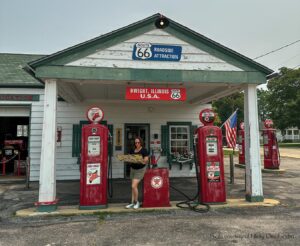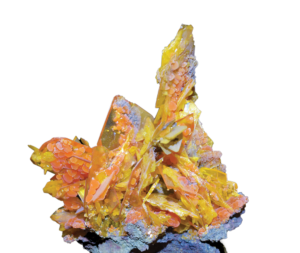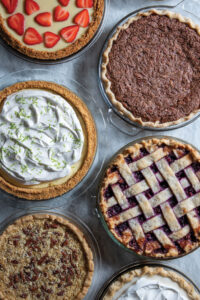Like many Illinoisans, Joshua Collins looks forward to the Illinois State Fair every year. So does Melanie Jacobs. Guy Alongi and Rex Duncan are eager for the start of Illinois’ other state fair, the Du Quoin State Fair, late each summer. Vicki King is fond of both 11-day events.
It’s not that Collins is an aficionado of corn dogs, and Jacobs isn’t much into thrills on the midway. Alongi doesn’t show cattle, you won’t find Duncan in the racing pits at Du Quoin’s Magic Mile, and King rarely buys a ticket for a grandstand performance. Yet, each of these individuals and countless others anticipate the fairs because of what Illinois state fairs do for the local and regional economies.
Simply put, the state fairs are big business – and they are good for business. For more than 150 years, the Illinois State Fair in Springfield and its state-run sister event in the southern Illinois community of Du Quoin, brings significant economic impact to their communities and regions.
“The economic impact these two events have on Springfield and Du Quoin, and surrounding communities, is immeasurable,” says State Fair Manager Kevin Gordon, who oversees both events. “They put people to work, they fill up our hotels, our restaurants, and they generate tax revenue.”
Together, the two late-summer events generate tourism, excitement, jobs and millions in economic impact not only for the two communities, but for their regions and the state as a whole.
Springfield
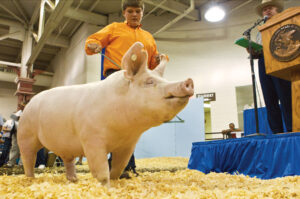 The state’s flagship fair, the Illinois State Fair (set for Aug. 10 through Aug. 20), has been a fixture, especially in the Illinois agricultural community, since 1853. Each year, more than 350,000 visitors enjoy displays, racing, competitions, carnival rides and games, “fair food,” concerts and, of course, the famous butter cow. For many families, the fair is an annual tradition. Not only is the fair a fun event, Illinois Dept. of Agriculture officials say the Illinois State Fair – and its sister event in Du Quoin – serve an educational purpose.
The state’s flagship fair, the Illinois State Fair (set for Aug. 10 through Aug. 20), has been a fixture, especially in the Illinois agricultural community, since 1853. Each year, more than 350,000 visitors enjoy displays, racing, competitions, carnival rides and games, “fair food,” concerts and, of course, the famous butter cow. For many families, the fair is an annual tradition. Not only is the fair a fun event, Illinois Dept. of Agriculture officials say the Illinois State Fair – and its sister event in Du Quoin – serve an educational purpose.
“The fairs are important tools used by the department to educate the public about the importance of our state’s No. 1 industry, agriculture,” says Gordon. “Agriculture is a billion-dollar industry in the state of Illinois, so education and promotion of our industry is vital.”
Both fairs also give fairgoers the opportunity to see entertainers and events they may not find anywhere else. In 2016, the Illinois State Fair featured the highest-grossing grandstand line-up in history, with ticket sales of $2.08 million. Both fairs feature concerts and other performers as well as horse, motorcycle and automobile racing.
Not only is the fair educational and a source of cultural activities, it has a significant economic impact on Springfield, Sangamon County and the region. A recent study conducted by the Regional Economics Applications Laboratory at the University of Illinois reported $86 million in business volume to the local economy by the Illinois State Fair. This includes $35 million for wages and salaries as well as generating $2.67 million in sales taxes.
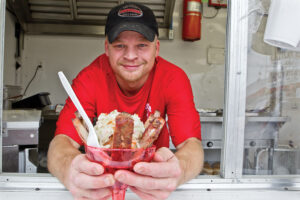 “There are businesses around the fairgrounds that definitely see an increase in business,” Joshua Collins, director of business and community development with the Greater Springfield Chamber of Commerce, reports. “The aggregate is very good because people come into town and spend money, plus there are the side businesses that are specifically related to the fair.”
“There are businesses around the fairgrounds that definitely see an increase in business,” Joshua Collins, director of business and community development with the Greater Springfield Chamber of Commerce, reports. “The aggregate is very good because people come into town and spend money, plus there are the side businesses that are specifically related to the fair.”
Many of those businesses are ones that cater to visitors, explains Gina Gemberling, executive director of the Springfield Convention and Tourism Bureau. “The visitor traveler visits restaurants, gas stations, hotels and retailers. It’s a high occupancy time for us in our hotels and many people are doing more than the fair,” she says, adding that many fairgoers also visit Lincoln sites and shop while they are in town.
“I’ve been attending the Illinois State Fair my entire life,” Illinois Department of Agriculture Director Raymond Poe says. “I’ve seen firsthand the number of people the fair puts to work from inside the fairgrounds to outside the fairgrounds. Not only that, but the people who come to the fair patronize our local restaurants, hotels, gas stations and the Lincoln sites, which has a direct impact on our local economy.”
One study a number of years ago reported that more than two-thirds of visitors to the Illinois State Fair were from outside of Sangamon County and specifically made the trip to Springfield for the fair.
The impact of the fair cannot be separated from the great impact of the Illinois State Fairgrounds. After all, the facility is used much more than just 11 days each year.
“The fairgrounds are important year-round because of all of the events that happen outside of the state fair,” Gemberling explains. “They are significant economic drivers. There are often multiple events each and every weekend.”
Events including motorcycle races, weddings, conventions, trade expos, livestock shows, medieval battle portrayals, and more all take place on the fairgrounds and inside the more than 150 buildings on the 360-acre grounds.
Often, area companies rely on the fairs, and other events on the grounds, for a significant part of their annual revenue. Many of these events, as well as the fair itself, utilize the services and products of outside companies.
“The fairgrounds in Springfield is a big part of our business. We’re at the fairgrounds all of the time,” says
Melanie Jacobs, owner of Best Expo, a company that provides pipe and drape for trade show exhibit booths and rental equipment for weddings, meetings and special events. During the Illinois State Fair, Best Expo is responsible for all of the pipe and drape throughout the fairgrounds, including inside 20 different buildings and governmental tents. “Miles of stuff,” Jacobs says.
“We probably keep a crew of at least 10 busy during the fair and the days leading up to the fair,” she notes. “We start setting up in July with show rings and other locations. The state fair is a big part of our total business. It is really significant to us.”
Du Quoin
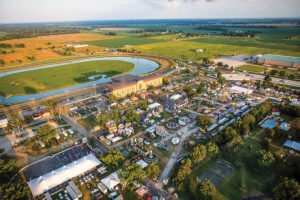 Illinois is unique in that there are actually two state fairs. The Perry County community of Du Quoin has been home to one since local resident William R. Hayes first envisioned a state fair on 30 acres of reclaimed strip mine. In 1939, Hayes began calling the event a “state” fair because he wanted a prestigious, statewide event. The event and fairgrounds both grew over the years (the fairgrounds now encompasses 1,200 acres), and even though dubbed a “state fair” for the first 63 years of the annual event, there was no affiliation with the Illinois State Fair until the State of Illinois purchased the fair in 1986.
Illinois is unique in that there are actually two state fairs. The Perry County community of Du Quoin has been home to one since local resident William R. Hayes first envisioned a state fair on 30 acres of reclaimed strip mine. In 1939, Hayes began calling the event a “state” fair because he wanted a prestigious, statewide event. The event and fairgrounds both grew over the years (the fairgrounds now encompasses 1,200 acres), and even though dubbed a “state fair” for the first 63 years of the annual event, there was no affiliation with the Illinois State Fair until the State of Illinois purchased the fair in 1986.
Former Du Quoin Mayor Rex Duncan understands the impact of the fair. He says it can be seen across the region, not just in the community of 5,900 residents.
“Du Quoin itself obviously sees a lot of traffic coming through with more activity in hotels, restaurants and gas stations,” he says. “We also see an increase in retail traffic because we have a lot of campers who start coming in early August for the fair. During that time, they are making Du Quoin their home so they are shopping here, eating here and being part of the community.”
He adds that when the actual fair rolls around (this year set for Aug. 25 through Sept. 4), there is sort of an economic ripple effect throughout southern Illinois. “We don’t have the hotel capacity to accommodate everyone, so the fair also brings visitors to Pinckneyville, Benton, Mount Vernon and Carbondale, so there is a secondary impact there as well.
Philip “Mike” Beard, executive director of the Mount Vernon-based Jefferson County Chamber of Commerce, says the Du Quoin State Fair has an impact on his community in terms of hotel stays, restaurant traffic and retail purchases.
A U of I study on the Du Quoin fair measured a $6 million economic impact to the region from the fair alone. Current Du Quoin Mayor Guy Alongi says, as in Springfield, the true impact is much greater when you consider the fairgrounds all year long, not just in late summer.
“If you look at what the non-fair events generate, it could mean as much as the fair itself,” he says pointing to events such as the annual Street Machine Nationals hot rod car show, camping rallies and gatherings, rodeos and softball tournaments, as well as motorcycle and automobile races. In fact, the fairgrounds are home to one event or more for about 335 days each year.
“I look at the Du Quoin State Fairgrounds as a driving force for Du Quoin and an economic engine for all of southern Illinois,” he adds.
Plus, there is just a recognition factor for the community, which, without the fair, would not be as well known.
“Just the notoriety of having the fair here is so important,” Alongi says. “The Du Quoin State Fair track, for example, is known all around the country as one of the fastest dirt tracks in the nation, if not the world. To have the fair here is important to us and to the region. The fair is the centerpiece of Du Quoin and has helped this city for so many years.”
Statewide Impact
 The economic impact of the two state fairs is not limited to Springfield and Du Quoin or even the vicinity of the two fairgrounds. Businesses from throughout the state and nation benefit from the fairs, such as Herrin-based King Food Service which serves as concessionaires at both Springfield and Du Quoin. Vickie King, co-owner of the company, is behind the iconic taffy stands located throughout the fairgrounds, a Springfield tradition for nearly 90 years.
The economic impact of the two state fairs is not limited to Springfield and Du Quoin or even the vicinity of the two fairgrounds. Businesses from throughout the state and nation benefit from the fairs, such as Herrin-based King Food Service which serves as concessionaires at both Springfield and Du Quoin. Vickie King, co-owner of the company, is behind the iconic taffy stands located throughout the fairgrounds, a Springfield tradition for nearly 90 years.
“We have four trailers in Springfield each year and at least that many in Du Quoin,” she says, adding that often the company’s presence at Du Quoin includes other food items in addition to the taffy, sometimes including as many as 22 concession trailers. “When vendors like us come into a community, it’s not just us that is making money, it’s everyone in town. When we come, we go shopping, we go to the grocery stores, restaurants, and gas stations. Plus, we’re all paying sales taxes and that rolls right back into the communities.”
King points out that employees are paid, too, spending their wages both in the fairs’ host cities as well as in their own hometowns. She adds that while her company participates in state fairs throughout the Midwest, the Springfield and Du Quoin events are a priority for her and her company.
“These fairs are important from a community standpoint for us,” she explains. “These are our home fairs. If we weren’t there, there would be a void. I love the Illinois State Fair and Du Quoin State Fair because they are home.”
Jacobs’ company also is part of activities in Du Quoin as well, providing services for events such as the Illinois Product Expo.
King says when one considers all of the people who come to the fairs to work, there are significant dollars generated – and spent.
“Look at how many trucks the midway companies have. They have to fuel those trucks,” she says. “They are taking money and spending it in the community. I mean, we all need to restock our campers and our concession trailers.” She adds that many vendors also provide temporary jobs during the fairs.
“There may be as many as 30 people we hire locally. We spend a lot of money when we roll into a community; money that stays in the community. The fairs have a big impact on all of us.”
The two state fairs are just part of a bigger picture showing the benefits of fairs throughout the state. A separate University of Illinois study showed that at county fairs $170 million was spent in 2014, with more than half of expenditures happening directly in the Illinois economy. The report also indicated that fairs continue local traditions and build unity among Illinois communities and families.
If you’re planning to attend one or both state fairs, just know that whatever the reason to attend either late-summer event, the local and state economy get a boost with every corn dog eaten, every show ticket purchased and every carnival ride ridden. For more information, visit Illinois.gov/StateFair for the Illinois State Fair and Illinois.gov/sites/dsf for the Du Quoin State Fair.





